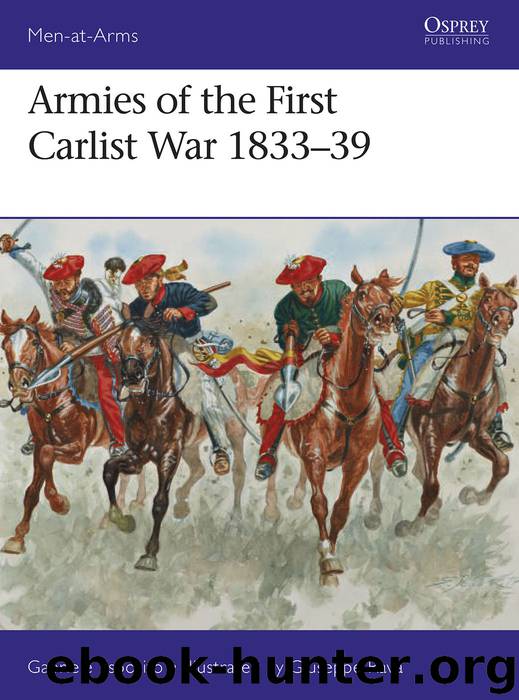Armies of the First Carlist War 1833–39 by Gabriele Esposito & Giuseppe Rava

Author:Gabriele Esposito & Giuseppe Rava
Language: eng
Format: epub
ISBN: 9781472825247
Publisher: Bloomsbury Publishing
Published: 2017-08-21T16:00:00+00:00
Castilian cavalry of the Army of the North; troopers from that province formed a number of usually short-lived provisional units raised for expeditions into Liberal-held territory, but Castilians made a longer-lasting contribution to Cabrera’s Army of the Centre in Aragon. For colours, compare with Plate H3, except for the white summer trousers shown here.
The organization of the Navarrese and Basque battalions remained quite stable throughout the war, but the same could not be said of units from Castile. Apparently, a total of 12 Castilian battalions were raised during three Carlist expeditions into central Spain, this term being applied very broadly to any deserters, pressed prisoners, or volunteers taken up during the expeditions into Liberal-held provinces (and even to a unit of deserters from the Portuguese Auxiliary Division – see below). Consequently, these units – other than the original nucleus of 4 battalions – were usually short-lived.
The Tropas de la Casa Real (‘Troops of the Royal House’) were two small units formed by Don Carlos to bolster his royal dignity. The initial ‘Halberdiers of the Royal Honour Guard’ numbered 100 young local aristocrats who were actually armed with Baker rifles: 20 from each of the three Basque provinces, and 40 from Navarre. Later renamed the ‘Honour Guard of Infantry’, this company acted both as a bodyguard and a sort of military academy: on leaving, guardsmen were promoted to lieutenant and went to serve as infantry officers. There was also a similar carbine-armed ‘Honour Guard of Cavalry’ numbering just 25 volunteers, who acted as Don Carlos’s personal mounted escort before being commissioned into the cavalry. To be admitted to either unit, a young nobleman had to have already served in the army for two years, and to have taken part in at least two actions. On 13 December 1837 the Household Troops were augmented by the creation of a new 30-strong Escolta para el Estandarte de la Generalísima. Also armed with carbines, this provided the ceremonial escort for the Carlists’ sacred flag of the Virgin Mary.
Finally, the contribution to the Carlist cause made by Portuguese conservatives should be mentioned. Many of King Miguel’s supporters did not accept the peace of 1834, and, wishing to continue the fight against the liberal cause, a number of them went to Spain to serve as volunteers for Don Carlos. They formed an independent Portuguese Company within the Army of the North, which was later expanded into a battalion with deserters from the Liberals’ Portuguese Auxiliary Division.
Download
This site does not store any files on its server. We only index and link to content provided by other sites. Please contact the content providers to delete copyright contents if any and email us, we'll remove relevant links or contents immediately.
| Africa | Americas |
| Arctic & Antarctica | Asia |
| Australia & Oceania | Europe |
| Middle East | Russia |
| United States | World |
| Ancient Civilizations | Military |
| Historical Study & Educational Resources |
Life of Elizabeth I by Alison Weir(2026)
The Invisible Wall by Harry Bernstein(1765)
Art of Betrayal by Gordon Corera(1401)
1916 in 1966 by Mary E. Daly(1231)
Thunderstruck by Erik Larson(1181)
The Decline and Fall of the British Empire, 1781-1997 by Piers Brendon(1096)
A Brief History of Britain, 1066-1485 by Nicholas Vincent(1009)
A Brief History of Britain, 1485-1660 by Ronald Hutton(978)
Guy Burgess by Stewart Purvis(971)
Mary, Queen of Scots by Weir Alison(961)
Henry VIII by Alison Weir(909)
The Last Lion 02 - Winston Churchill - Alone, 1932-1940 by William Manchester(908)
Lang Lang by Lang Lang(833)
1066 by Andrew Bridgeford(829)
The Last Plantagenet by Thomas B Costain(810)
Gimson's Kings and Queens by Andrew Gimson(810)
Coalition by David Laws(806)
London: A Biography by Peter Ackroyd(803)
Diana by Andrew Morton(785)
